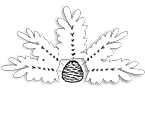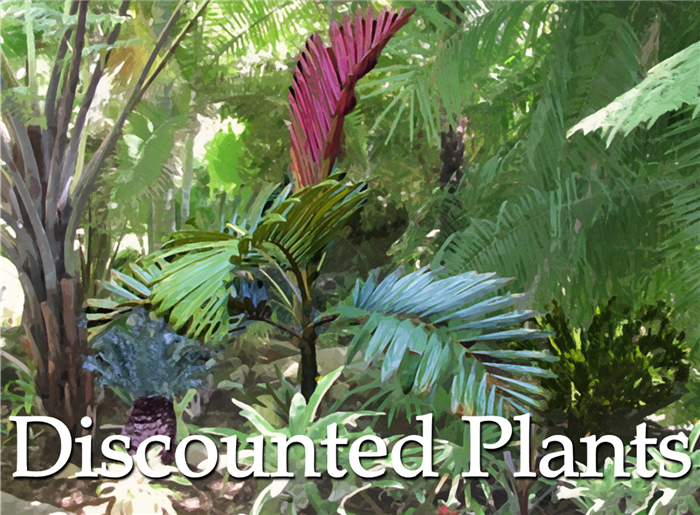by Phil Bergman
A Discussion of Palm Trees That Can Be Successfully Grown Indoors as Interior Houseplants
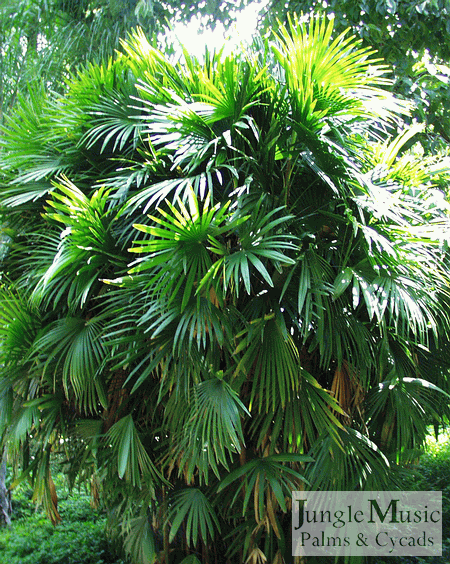
Introduction
This article discusses the usage of palms as houseplants – interior palm trees that do well inside the home or office. Over the past several hundred years, palms have been quite popular as house plants. During previous centuries, when taxonomists would search across great expanses of sea and land for new plant species with economic value, these plants (some of them palms) would be returned to their home institution’s conservatory and grown. They were not searching for plants destined to be interior plants per se. But, some proved adaptable and complementary to the home environment and have proven successful as indoor plants. Some did not. Since that time, nurserymen have found, usually through trial and error, which species of palms do well as houseplants. What we’ve learned over past decades is that , historically , there are three main tried and true genera of palms that do well as houseplants. They are: Howea forsteriana (Kentia Palm), Chamaedorea (Bamboo Palms) species, and Rhapis species (Lady Palms). In previous decades, these three types of palms have been the mainstay for interior palms. However, with more species being grown, we’ve found that there are other species that will survive indoors just as well as those three groups above. This article will discuss these basic three and varieties of them, but also deal with some more recent introductions that show good promise for interior growth.
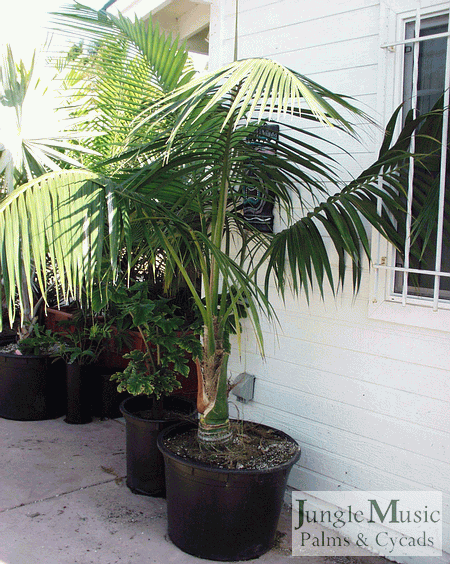
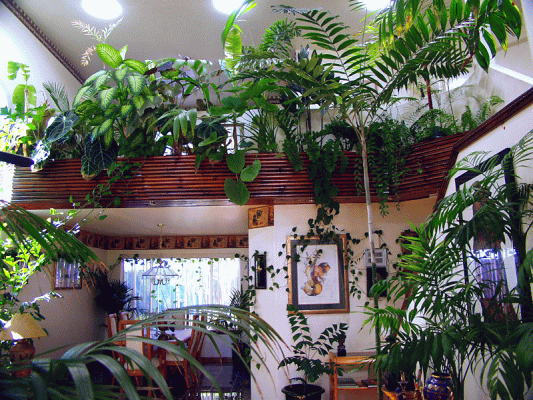
Assorted indoor plants.
BASIC PALM TREE CULTURE AND LIMITATIONS
Remember that nature has not provided us with houseplants. Rather, we look for and give a try with species, hoping that they will survive indoors. If a given plant does not do well inside, it is not then considered an indoor plant. If they do survive easily indoors, they become known as a houseplant. However, genetically they were not designed to live indoors. They just happen to tolerate the abuse given when someone takes them from their native environment and sticks them in a living room. Indoor plants, including palms, may need special attention. The ones that need the least attention have typically proven to be the most popular interior plants.
Therefore, the success of growing a houseplant is to try to reproduce the environment that it would prefer; with palms, this is often high humidity, warm temperatures, and good air circulation. The interior of a home can typically provide the warmth, but the humidity is often lacking because of the use of air conditioning and heaters. Air circulation is usually totally lacking. One can go so far as putting in humidifiers, setting up fans throughout the house, and maintaining a constant warm temperature. With these things properly done, there are probably many species that can be grown in the home environment. But, if you don’t want to do all of these things, it is better to stick with some of the basic, tried and true species.
Below I have special note on two things that are extremely important to enthusiasts with house plants: water and fertilizer. I receive lots of inquires about both. So do read on with comments about how to handle watering and fertilizer on palm plants.
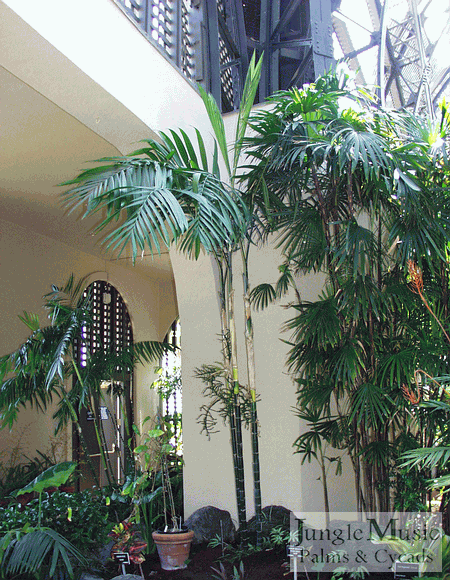
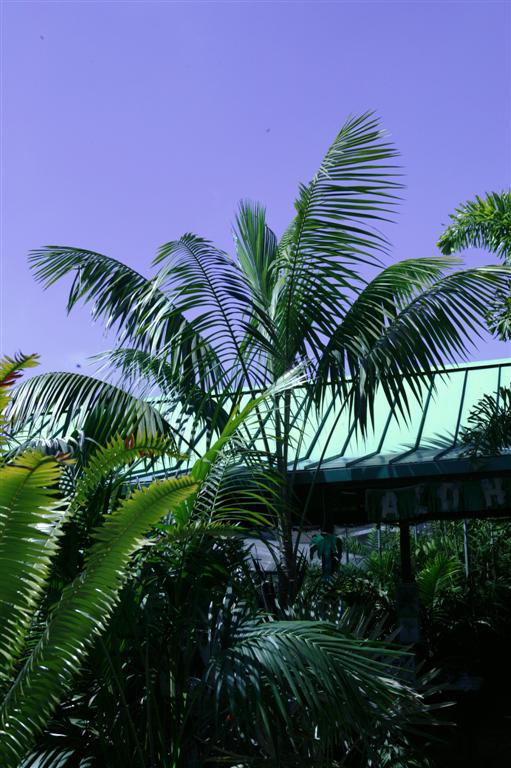
PALM SPECIES FOR INTERIOR CONDITIONS
Howea forsteriana, the Kentia Palm
Howea forsteriana, the Kentia Palm, is an excellent palm for inside because it is slow growing and very tropical appearing. In Southern California it is also an excellent exterior palms in coastal areas. It is a single trunk species, but often planted with two or three plants in the same pot, thus giving a more full appearance. This palm is rather slow growing; it takes six to seven years to get a nice 15 gallon plant. If planted in a large enough container, it can get up to 15 to 20 feet inside in a few decades. Restricting pot size will keep it somewhat smaller. From a small plant, about one foot tall, one could estimate that it would reach the average nine foot ceiling in about six to eight years. The Kentia palm is very popular because it has the classical tropical palm appearance: pinnate leaves & arching and drooping leaflets. It is also known to tolerate small containers (being under potted) and will tolerate the soil drying out a bit. It prefers strong indirect light or part sun through a window. Watering should be done when the top inch of soil starts to dry out on your palm plant. As it gets bigger this indoor palm tree will stretch toward your ceiling, so make sure you have room if you are getting a larger plant. Picture to the left shows a larger boxed specimen.
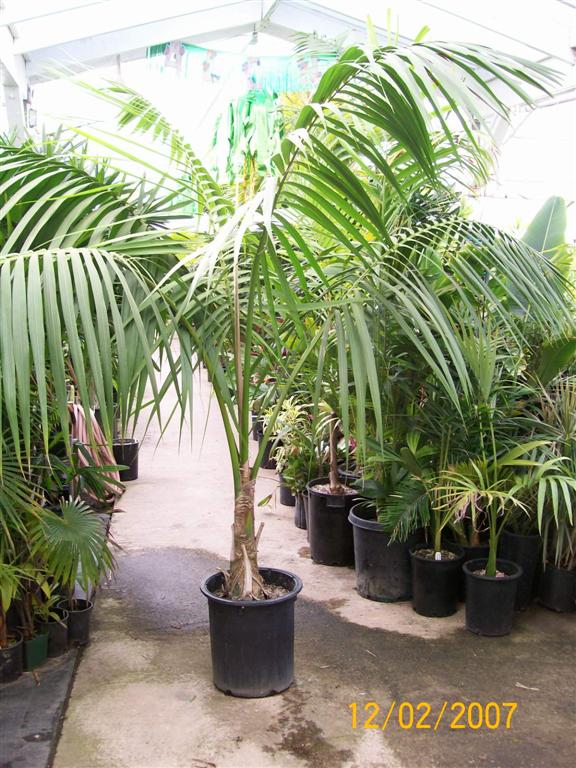
Howea forsteriana 15g
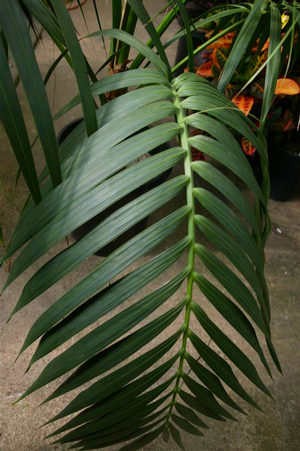
Howea belmoreana – the Belmore or Sentry Palm
This is another and more rare type of Howea palm. It also is native to Lord Howe Island. It is even slower growing and has leaves that curve downward giving it a more “umbrella” shape to the crown. It is known as the Belmore Sentry Palm or Curley Palm. It is difficult to find, but many seek it out and prefer it over the standard Kentia Palm. In the picture below you will note the more curved leaves.
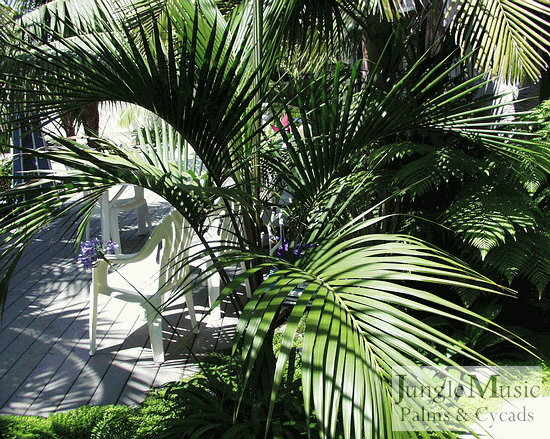
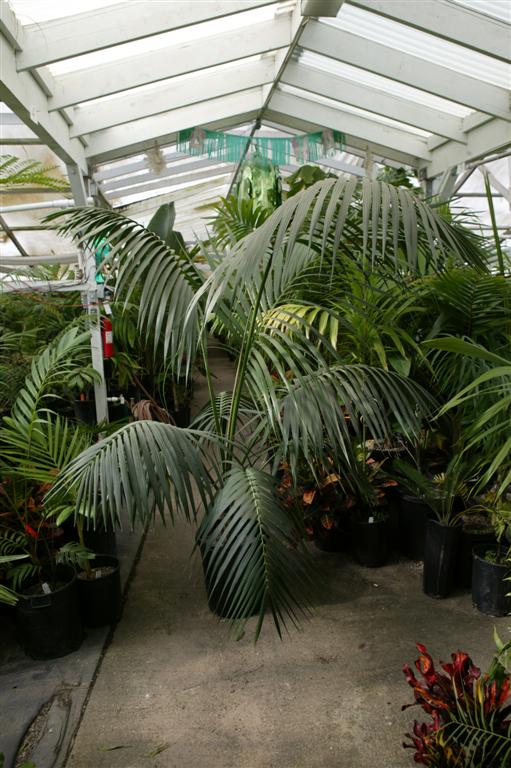
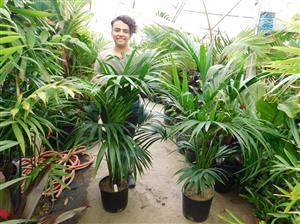
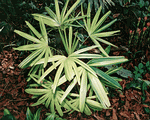
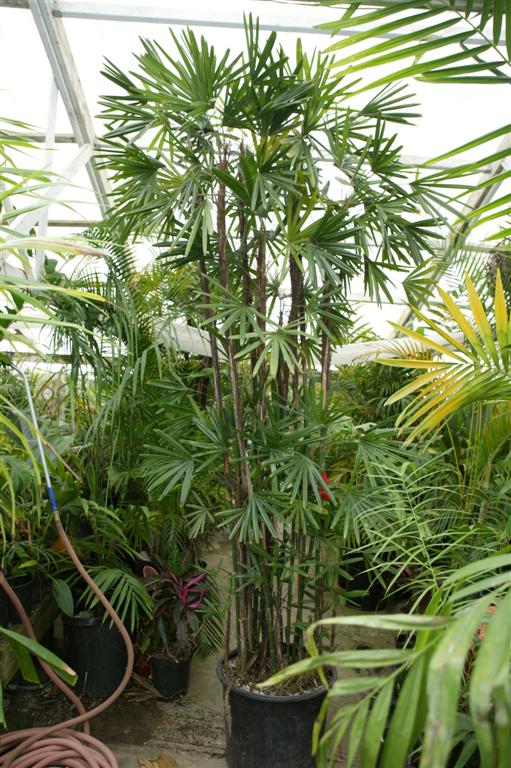
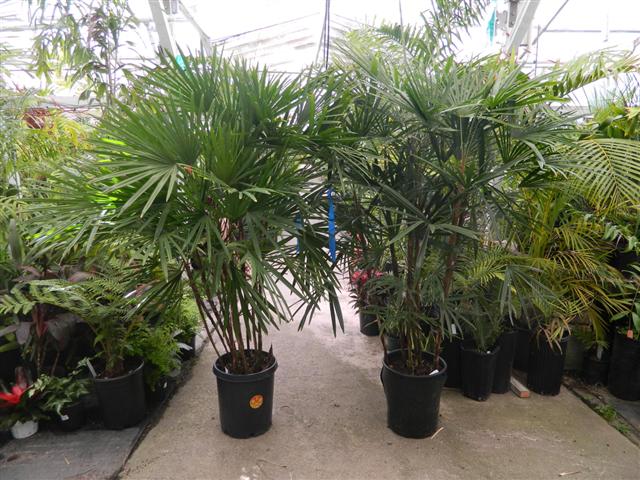
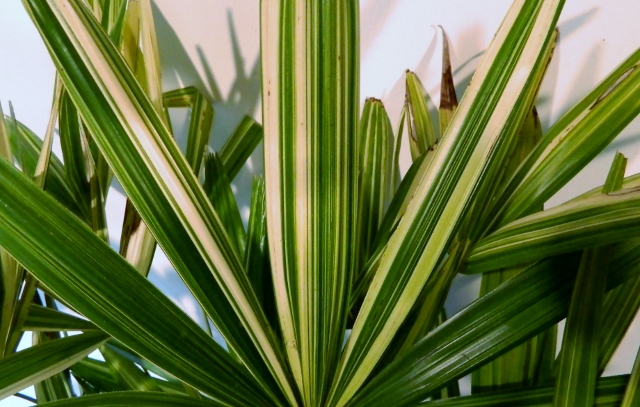
Rhapis excelsa – the Lady Palm
Rhapis excelsa, or the Lady Palm, is another beautiful indoor plant. Rhapis excelsa are a fan palm with thin trunks that sucker freely and form a clump of stalks. The typical height of this species at maturity is about five to seven feet, although there are varieties that are taller forms and some that are miniature forms. The plant to the left appears to be about 12 feet tall, which is quite tall for this species. It tolerates mild indirect light and is slow growing. It takes between five to ten years to reach its ultimate height. All Rhapis tend to be expensive because of their slow growth rate. No Rhapis like strong fertilizer and prefer distilled water. Rhapis will tolerate less sunlight than will the Kentia Palm. They like a rich organic soil with some sand and should be watered when the soil begins to dry out.
Very sought after are the variegated varieties, often fetching enormous prices at a nursery. There are many varieties of these and in some parts of the world they are highly coveted. There are sometimes near impossible to find. See photo to left.
Rhapis humilis- The Slender Lady Palm
This is another type of Rhapis that tends to be taller than R. excelsa and can tolerate brighter light, perhaps right in front of a window. Heights vary from ten to twenty feet. The trunks are more tidy than the standard Lady Palm and the leaflets are more plentiful, thinner and typically come to a point on the end. However, they are usually much more expensive than Rhapis excelsa. As with all types of Rhapis, do not over fertilize and use distilled or reverse osmosis water if possible.
Rhapis multifida
Another species, Rhapis multifida, are like R. humilus, but only get to about 8 feet tall and make great indoor plants. This would be an ideal selection for someone who likes R. humilus but has lower ceilings. The trunks are quite thin as are the leaflets. This species is an ideal interior palm. Some nurseries will call this species Rhapis humilus because they are not familiar with it or have made a mistake in identifying it.
Rhapis species other
Rhapis species other
There are several other types of Rhapis which are very rare. They vary in the appearance of the leaflets, cane size, overall height, and growth characteristics. It is beyond the purpose of these articles to discuss them here, but realize they do exist. This does include various rare hybrid forms such as the Rhapis humilus X laoensis below.
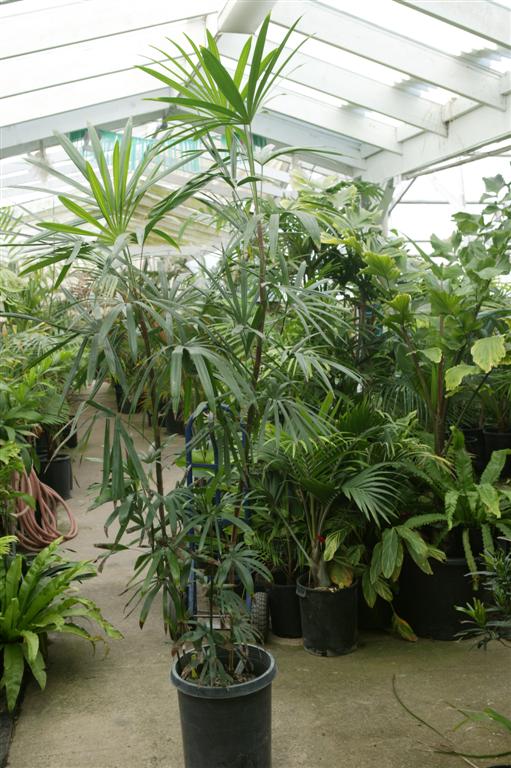

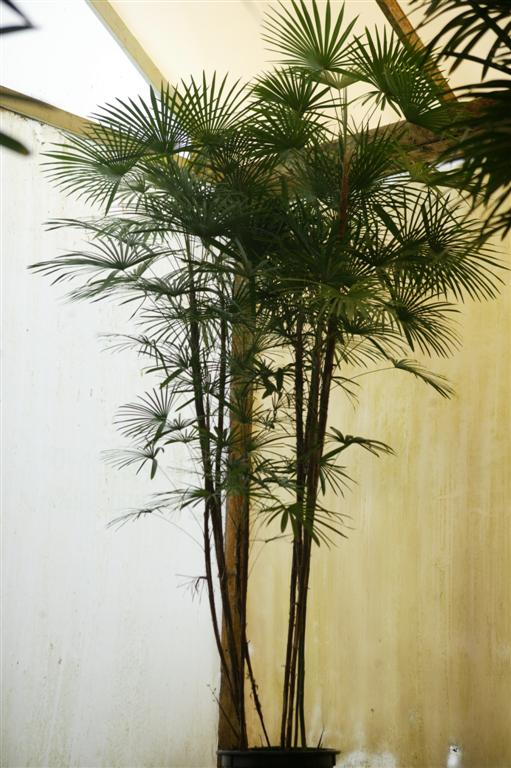
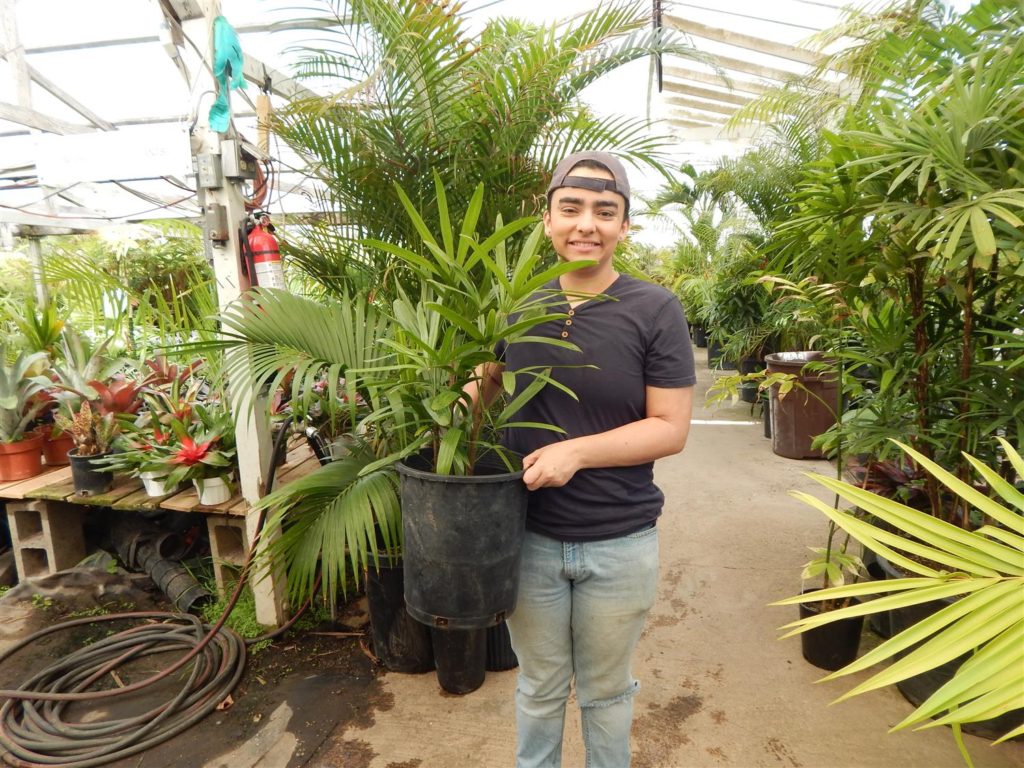

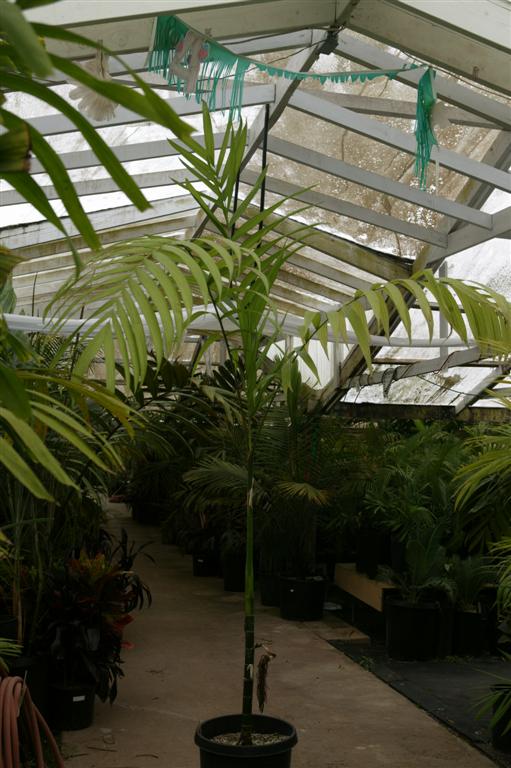
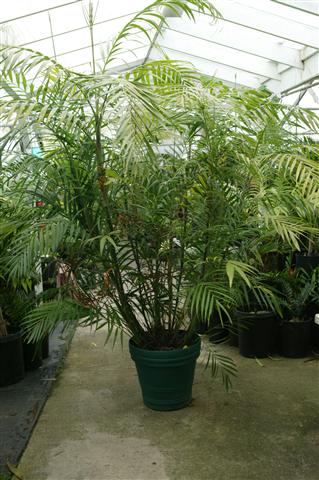
Chamaedorea species
Chamaedorea palms are a group of palms that consists of over 200 species. Some are single trunk, others sucker. Some are quite short while some species get up to about 20 feet. There is a Chamaedorea species for almost everyone’s taste and many do great in the house. As a group (especially when they sucker)they are known as bamboo palms, but many of them don’t look like bamboo at all. In fact, some have simple, solid leaves and are quite unique in the plant world. Most have the classic and “palmy” pinnate leaves. Below are some of my favorite.
Chamaedorea costaricana
Chamaedorea costaricana
This is a fantastic species that gets to about 10 to 14 feet. It suckers and typically at maturity has about 10 to 20 stems. You’ll see shorter young trunks with older ones overhead. It is somewhat hard to find nowadays but is a great species. The picture to the left shows one adjacent to a house, but rest assured it is a fine interior species.
Chamaedorea radicalis
This is an totally different species. It is a dwarf , single trunk plant that never gets over about 3 to 4 feet. It has a prominent orange blossom that shoots above the foliage and, if a female, sets beautiful black seeds. There is also a trunking form of this species that gets up to about eight to ten feet. See photos to left.
These two species are also known for their fairly good cold tolerance. The dwarf form will take temperatures into the upper teens F.
Chamaedorea tepejilote
This is a beautiful species with a rather thick trunk, is single stemmed, has long wide leaflets and gets to about 14 to 16 feet. Planted as several in a pot (get stair stepping of plants as time goes on), this species is very attractive. It has dark green trunks with prominent rings and wide leaflets. There is also a rare suckering form of this species which we offer at the Nursery. You can see the suckers forming at the base of the main trunk in the photos below.
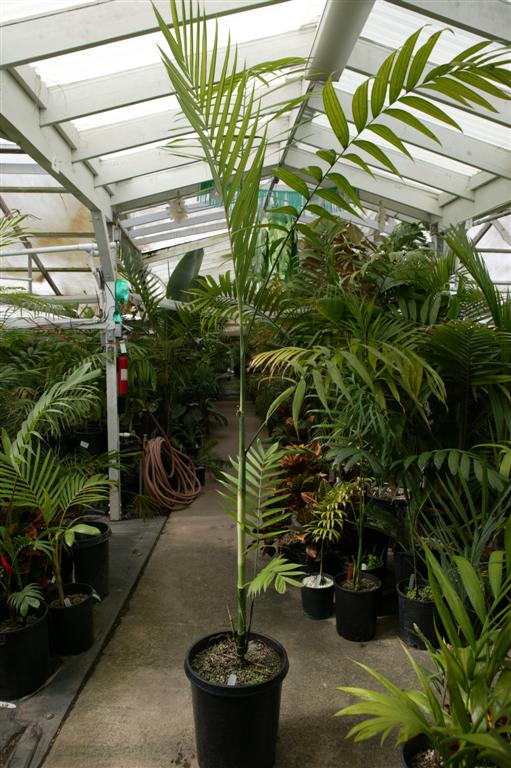

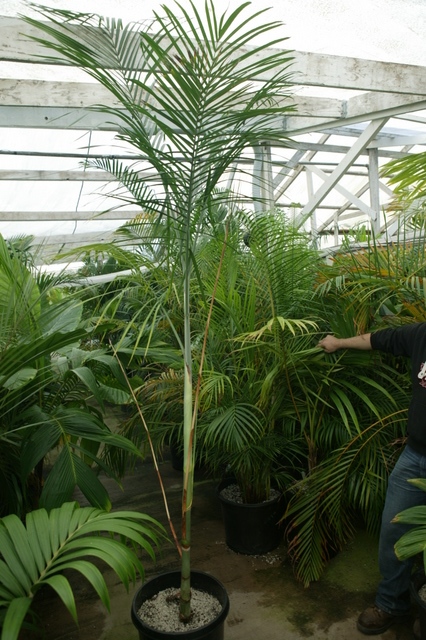
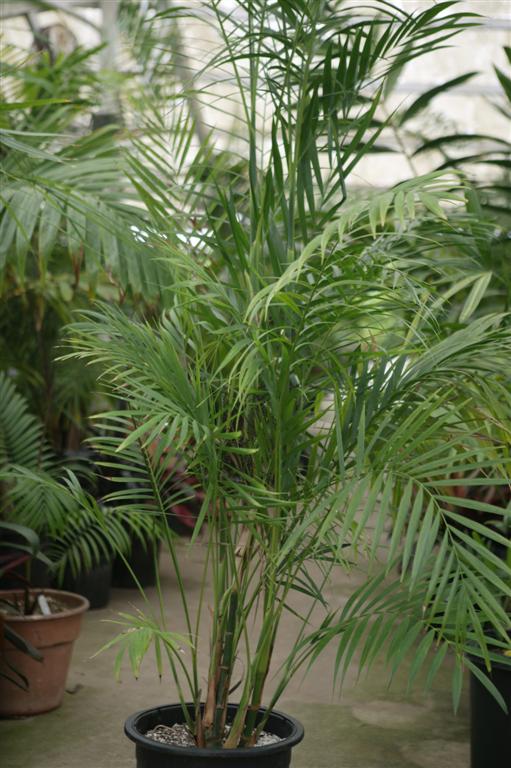
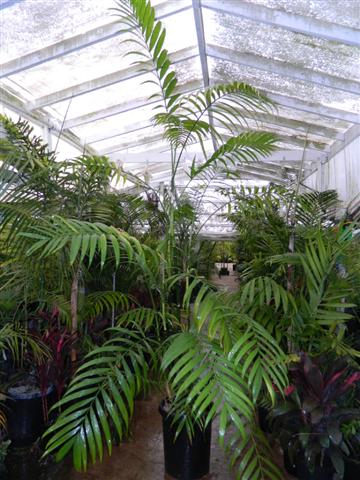
Chamaedorea hooperiana
This is a very popular suckering type of Chamaedorea that seems to have some immunity to pests and is easy to grow. It gets to about 10 feet and is quite lush and full. Leaves are longer than C. costaricana. It doesn’t seem to lean out too much and has thin trunks. It is also fairly quick growing. See photo to right for 15g size and to left for mature specimen plant.
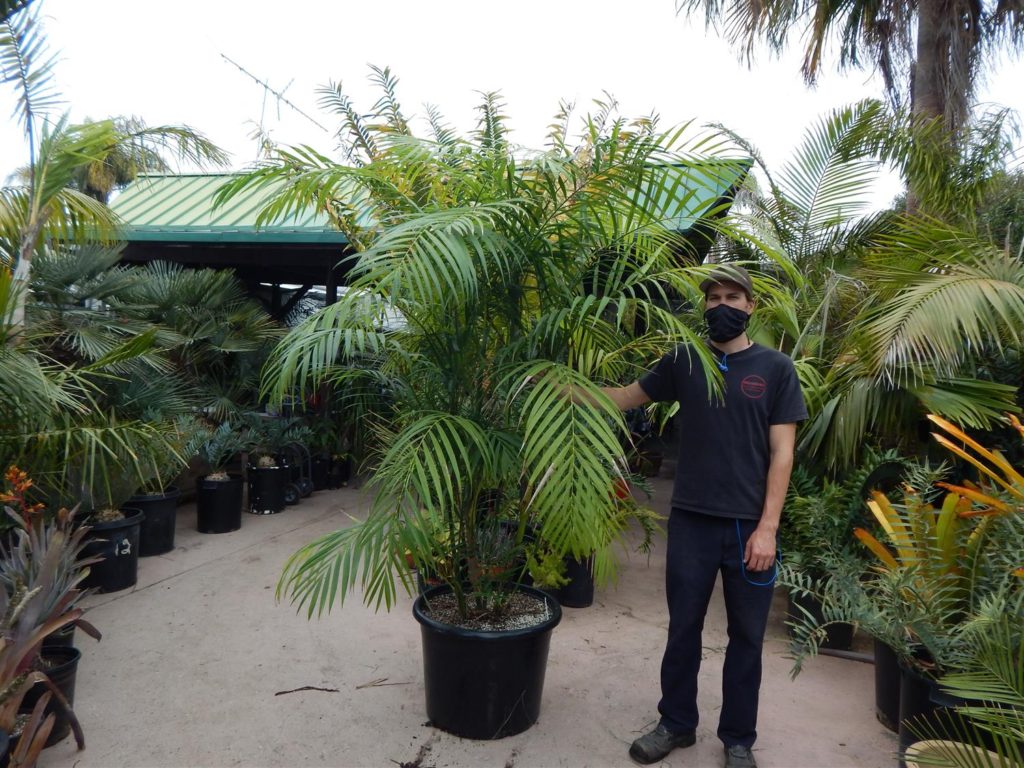
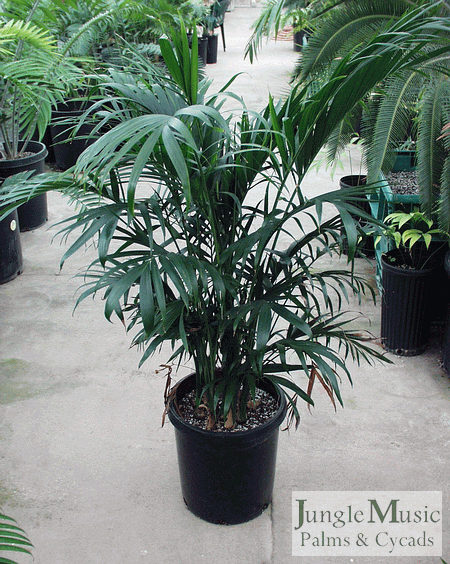
Chamaedorea seifrizii
This is one of the older Chamaedorea species around in cultivation. It only gets to about 8 feet and has very thin trunks. It is the classical “Bamboo Palm”. It can ber susceptible to fungal infections. Photos to left shows a medium sized nursery plant.
Chamaedorea ernesti-augusti
This is a dwarf species, rarely getting over 6 feet. It has simple, solid leaves and is very attractive. In groups of two or three together, they are just gorgeous. It is an ideal species for someone who wants a shorter plant.
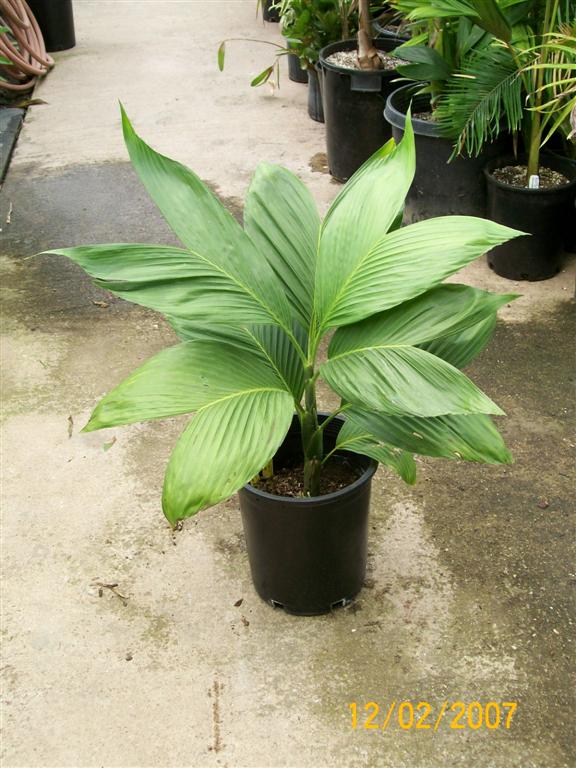
Chamaedorea plumosa
This is a tall, thin trunked and wispy Chamaedorea that is fairly new on the market. It gets up to about 14 or 16 feet and looks better as a group of three plants as shown to the right. For someone who wants a more “airy and open” look, this is an ideal choice. It tolerates bright light. See photo to the right.
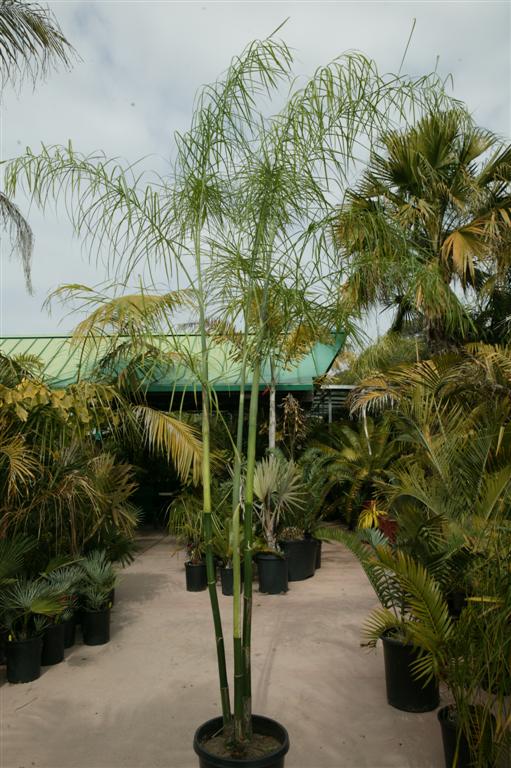
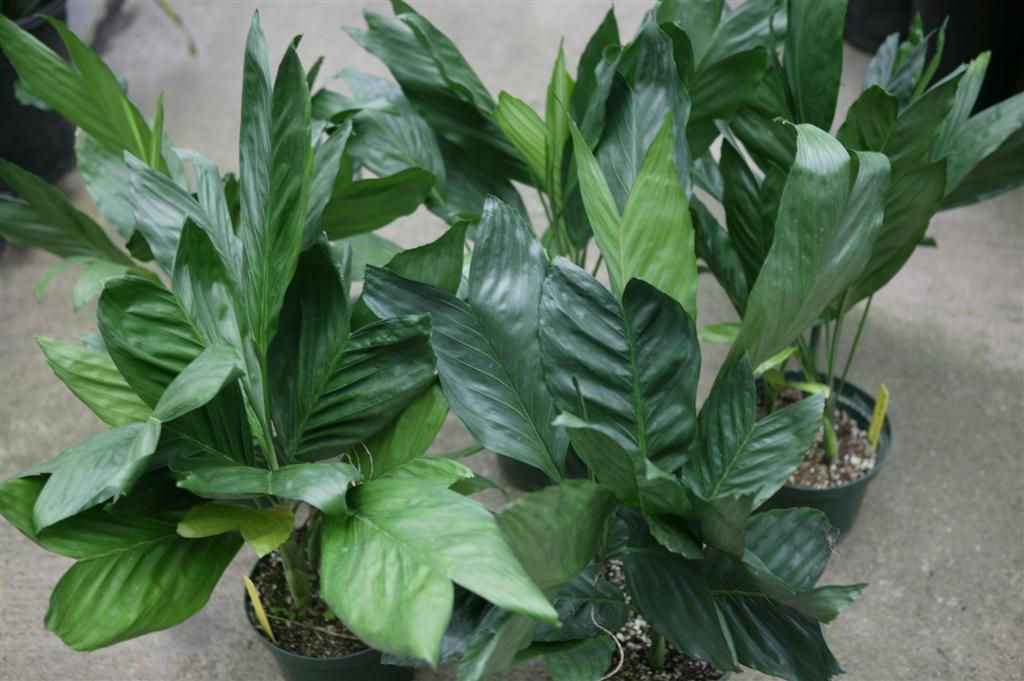
Chamaedorea metallica
This is another dwarf species of Chamaedorea that has a solid, simple leaf, never gets much over six feet and has a metallic sheen to the leaves. It doesn’t want too much light and is most attractive when grown in a group of three plants. See photo to the left.
Other Chamaedorea
There are many other species of Chamaedorea that can be grown indoors. We are growing over 30 varieties of this genus. Please contact us if you are interested in other types.
As a genera, Chamaedorea are easy to grow if one follows guidelines described below.
Chambeyronia macrocarpa – the Flame Thrower Palm
About ten to fifteen years ago we discovered that this unique species of palms was an ideal interior plant. It has an equal growth rate as the Howea forsteriana, but is crown shafted and has a newly emerging dark red leaf. Thus, it is an exciting addition to plants that can be grown inside. It has about a six inch thick trunk in a pot, sometimes smaller, and has wide, glossy green leaflets that are very thick.
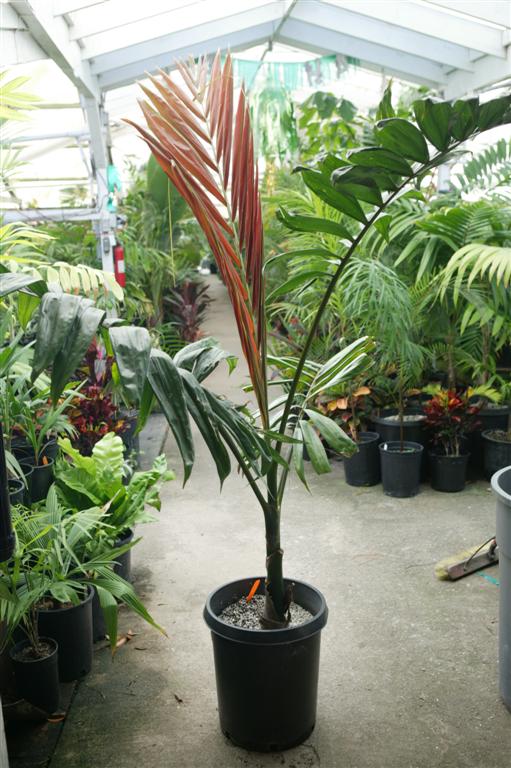
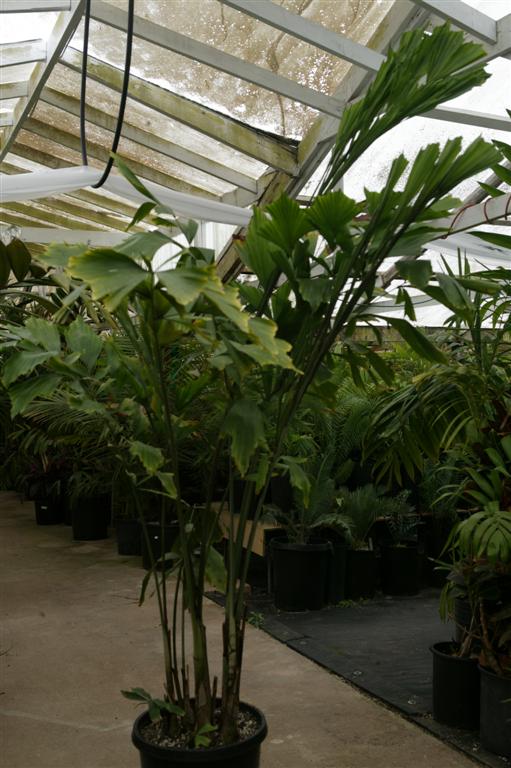
Caryota mitis – Suckering Fishtail Palm
This suckering palm is often called the Suckering Fishtail Palm and can be grown indoors. It gets to a height of about 10 feet in a pot. Contrast this to the single trunk varieties of Caryota which get way too tall for the average house but have been used in hotel lobbies and courtyards.
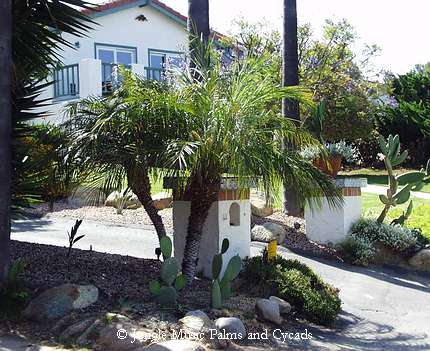
Sabal species
I have gotten reports that this genus seems to do well inside if it gets adequate sunlight. They are fan palms and fairly easy to grow. There are many types. The picture below will give you an idea of a Sabal palm. it is a smaller 5g size. Be aware that this genus can get pretty large leaves, so make sure you have enough room to grow it.
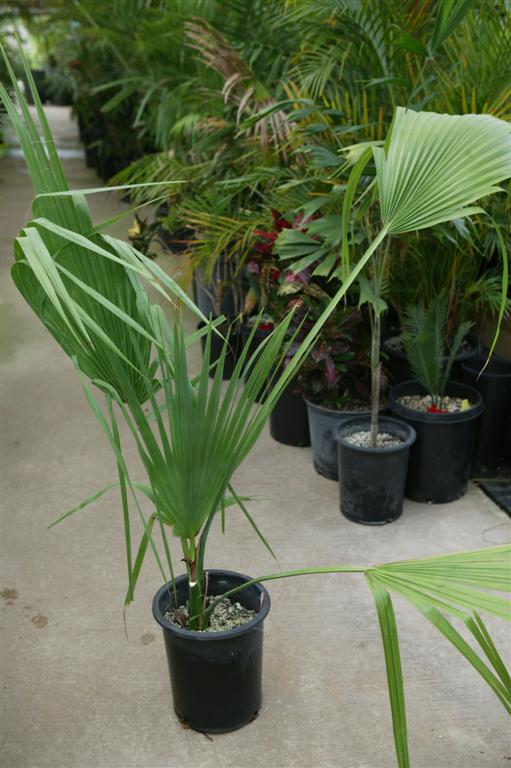
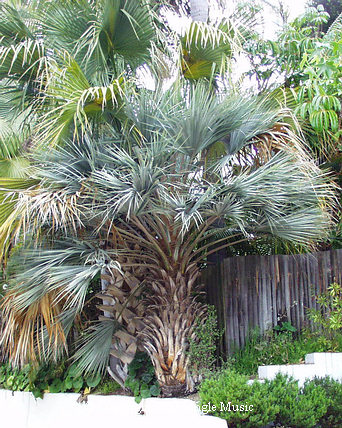
Other Possible Species
There are other genera that have been used with some success as houseplants, including types of Pheonix, Ptychsoperma, Veitchia, Livistona, Trachycaprus, Hedyscepe and a few more. We don’t have confirmation of the ease of growth of these inside, so will only mention them here. But, be aware that not all palms do well inside.
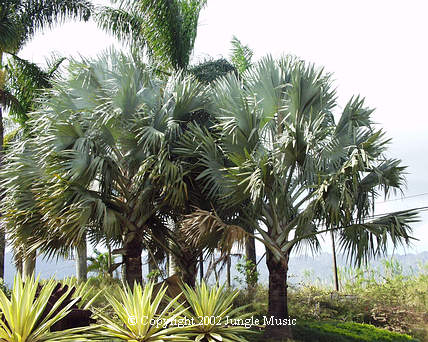
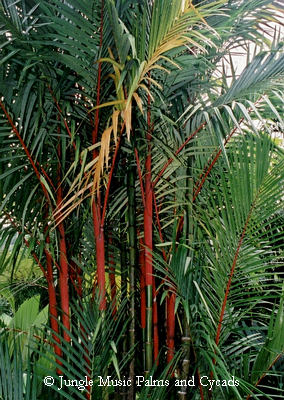
Palms Known to Have Problems as Houseplants
There are types of palms that do not do well as houseplants, including those that demand full sun (Brahea armata, Bismarkia nobilis, Archontophoenix cumminghaniana (King Palms), Syagrus romanofskiana (Queen Palms) and Ravenea rivularis (Majesty Palm). It is not that someone, somewhere hasn’t pulled off growing one of these species indoors. But, in general, they are not optimal. Special mention should be made about the Majesty Palm. It is certainly being marketed heavily as an interior palm. However, there are just too many people who have had trouble with this species. Therefore, we list it as one of the poor choices. Similarly, there are species that have demands of high humidity and/or absence of any cold. They may thrive in a greenhouse, but find difficulties inside the ordinary home. this would include such genera/species as Verschefeltia, most Licualas, Genomonas, Pinangas and Cyrtostachys renda (the red sealing wax palm). In general, because of their need for a more tropical environment, they tend to be poor choices for inside the house.
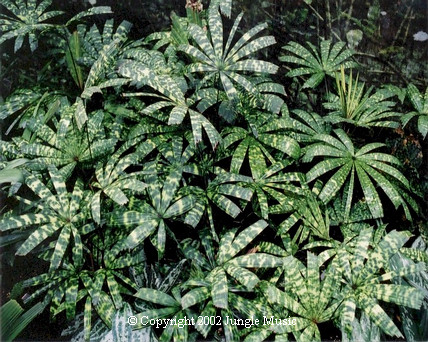

KEYS TO SUCCESS WITH INTERIOR PALMS
There are key cultural requirements that must be followed on palms as houseplants, but also on almost any interior plant. The first thing is to maintain adequate hydration of the soil without over-watering. This typically means one would water about once a week under most circumstances. Checking the top inch of the soil is helpful in finding out if you need to water. If the soil is dry one inch below the surface, you should water. If it is winter and you have a heater on, it would be best to provide extra humidity. This can be done to some extent by placing potted palms on a platter with damp gravel, or one can mist the leaves several times a day. A room humidifier can be very helpful, although this might lead to mold buildup on the carpets or walls.
It is important to pick proper light requirements for your chosen palm. Some palms like bright light, others can tolerate low light. But, most do need some light, either direct or strong reflected light. It is often quoted that “no palm will live in a closet”. I think this is absolutely a true statement.
Air circulation is also quite important. Good movement of air tends to reduce problems with insects. Opening windows is helpful, but sometimes small circulating fans might be needed.

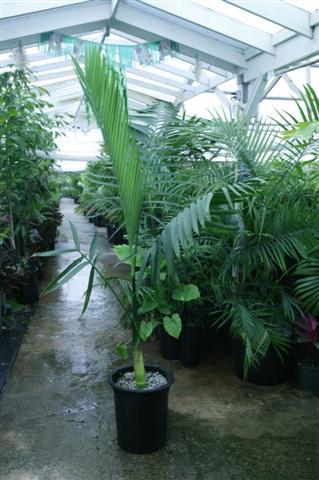
SALT BUILDUP IN THE SOIL
The most important thing I want to emphasize
The predictable problem of all house plants including palms is the gradual buildup of salts over time within the soil. Owners typically give the plant several cups of water. In the next week or two, the water evaporates and leaves the natural salts in the water behind in the plant’s soil. Think of the inside of your teapot. This is what happens in your soil. As time goes by, salts in the water (calcium, sodium, etc) build up in the soil; this eventually results in too hot of a mix. The plant begins to decline. First one notices brown edges on the leaves. Then the lower leaves brown entirely. Finally there are just a few sick looking leaves left. The treatment for this malady is to take the plant outside and water it ten to fifteen times. This leaches out all the salts. While outside, spray down the foliage. When the plant has drained all the water, bring it back indoors. Typically, I recommend leaching interior palms about three times a year. If one only waters with distilled water, this problem can be avoided to some extent. However, fertilizers do cause salt buildup as well. If you cannot take the plant outdoors and if it is not too big, give it a long shower in your bathroom.
Regarding fertilizers, most people prefer soluble fertilizers for houseplants. If using these, it is best to go on the dilute side. In other words, give less than recommended. Giving more leads to problems. Always follow the directions on the product you buy. If you havent leached your plant for a while, perhaps it is best to wait until after leaching before you fertilize. A timed-release fertilizer can work for houseplants as well. Never fertilize a plant with dry soil. And, remember the most important rule: too little fertilizer results in a slow growing plant; too much kills it!
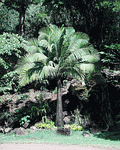
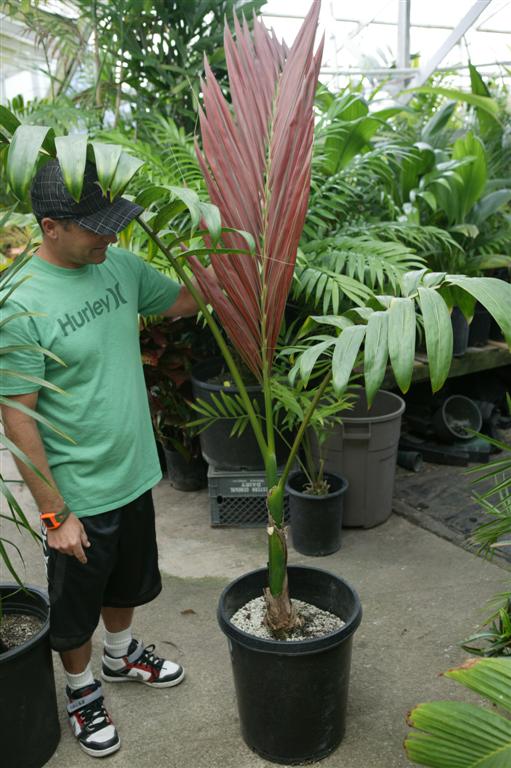
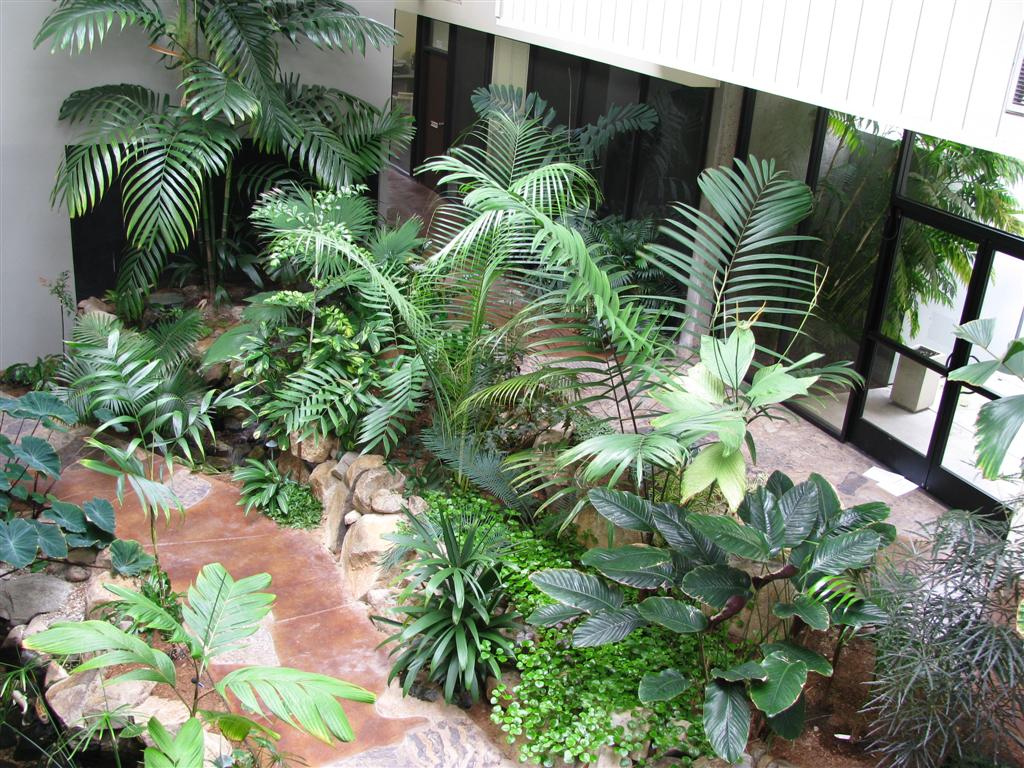
COMMENTS ABOUT SPECIAL INTERIOR AREAS AND SOLARIUMS
Some enthusiasts have created a special environment for growing palms or other plants inside. This may include an attached greenhouse or similar structure, a constructed solarium, a “pool room”, or a planter area with skylights. Such specialized areas often have humidity and temperature controls. This dramatically increases the number of species that can be grown. Sometimes this can be accomplished with a covered courtyard. The same applies with commercial buildings or lobbies. The two pictures to either side show the results of creating such an environment.
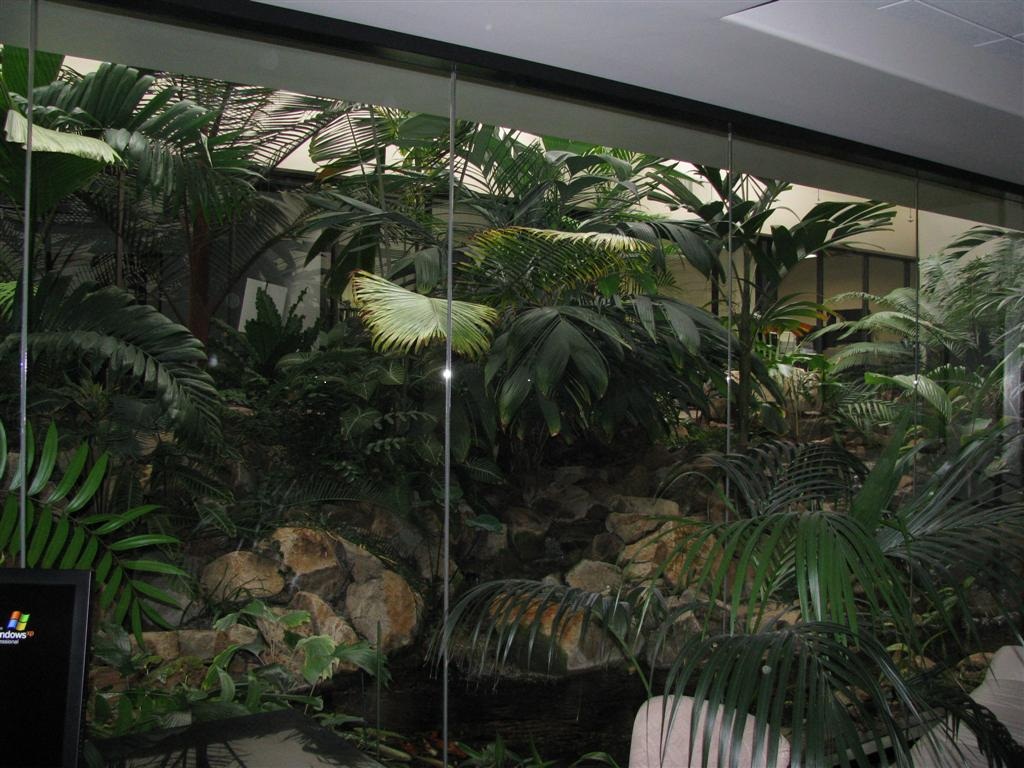
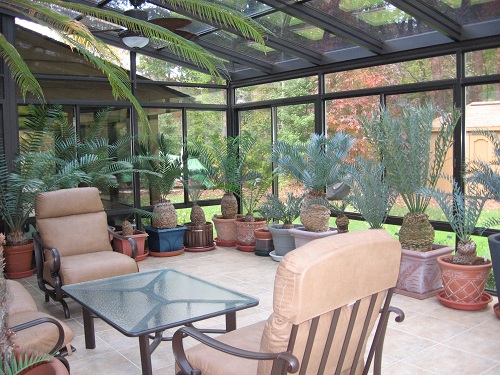
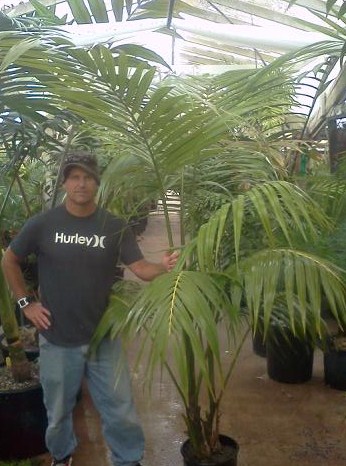
ALTERNATIVES TO PALMS IN INTERIOR LOCATIONS
There are certainly many types of plants that can be grown inside a home or office. People enjoy palm trees because there are so many species and they as a group have such a diversity in appearance. But, we realize other things make wonderful houseplants. As Jungle Music is also a cycad nursery with lots of experience with cycads, I wanted to mention the usage of cycads inside the home. It is an alternative to palms, and many species with many different forms and appearance can be grown inside. As a group, these Jurassic plants like bright sun. Some will tolerate less light. They don’t like to be overwatered. Most also don’t get as tall as many palms. The pictures to either side show usage of cycads in a home solarium located on the East Coast of the U.S. Cycads have a very architectural appearance and are quite primitive appearing. Mention should be made that cycads can be toxic if eaten by animals.
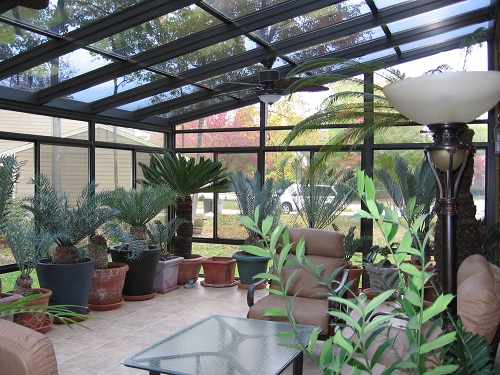
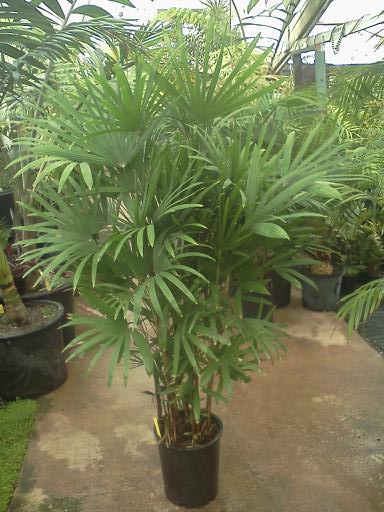
SUMMARY
If you love a certain species of palm, it is possible that you might succeed with that species inside your house. You may not. Nothing seems to have the appeal of a palm, so it may be worth the try. If you grow the species recommended above, you should succeed. Your success depends on what environment you create. If your thumb is on the brown side, it is best to stick to the tried and true species above. They are quite easy to grow. If you are a good grower, be courageous and give some new species a try. Mention has been made of special growing environments that increases the number of species you can grow. A predictable yet avoidable problem on all interior plants is the gradual buildup of salt in the soil.
As an alternative or in addition to palms, consider cycads or other tropical plants inside the house. These groups of plants are very impressive. Our nursery does mail order palms as well as other exotic plants, so you too can have fun with indoor plants. Check elsewhere in the website for ideas. To mail order, just call us. And, have fun and good luck!
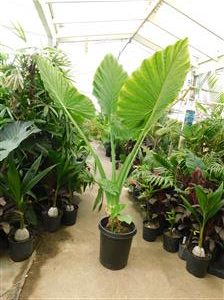
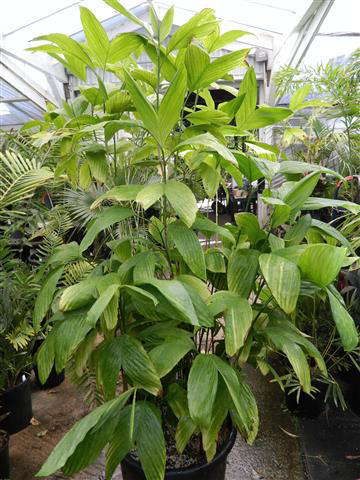
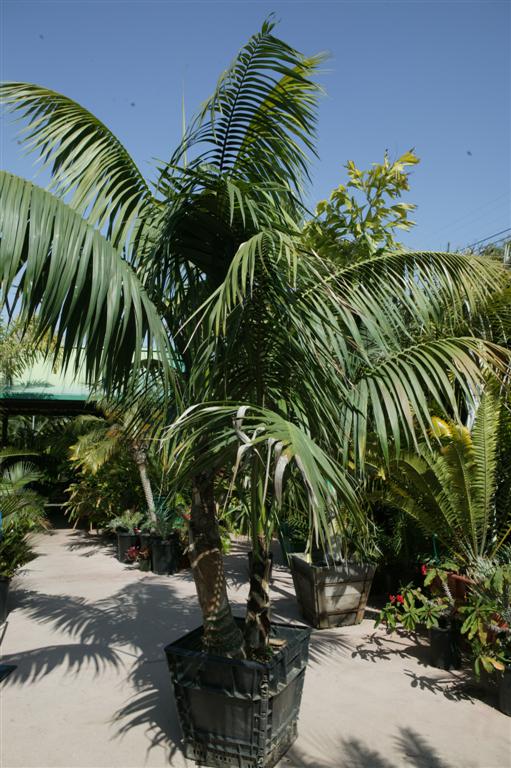
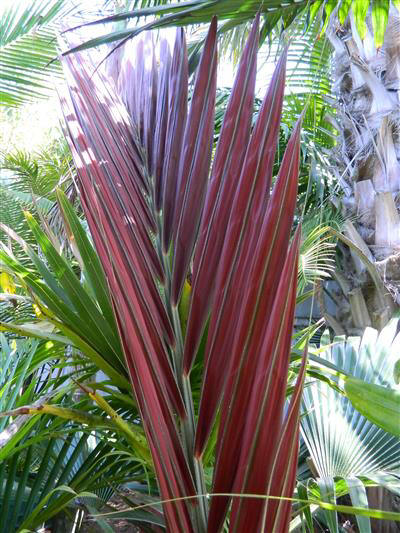
- PALM TREES, CYCADS & TROPICAL PLANT BLOG - October 1, 2020
- TRACHYCARPUS
The Windmill Palm - September 30, 2020 - FAN PALMS –
PALMS WITH CIRCULAR LEAVES - September 29, 2020
